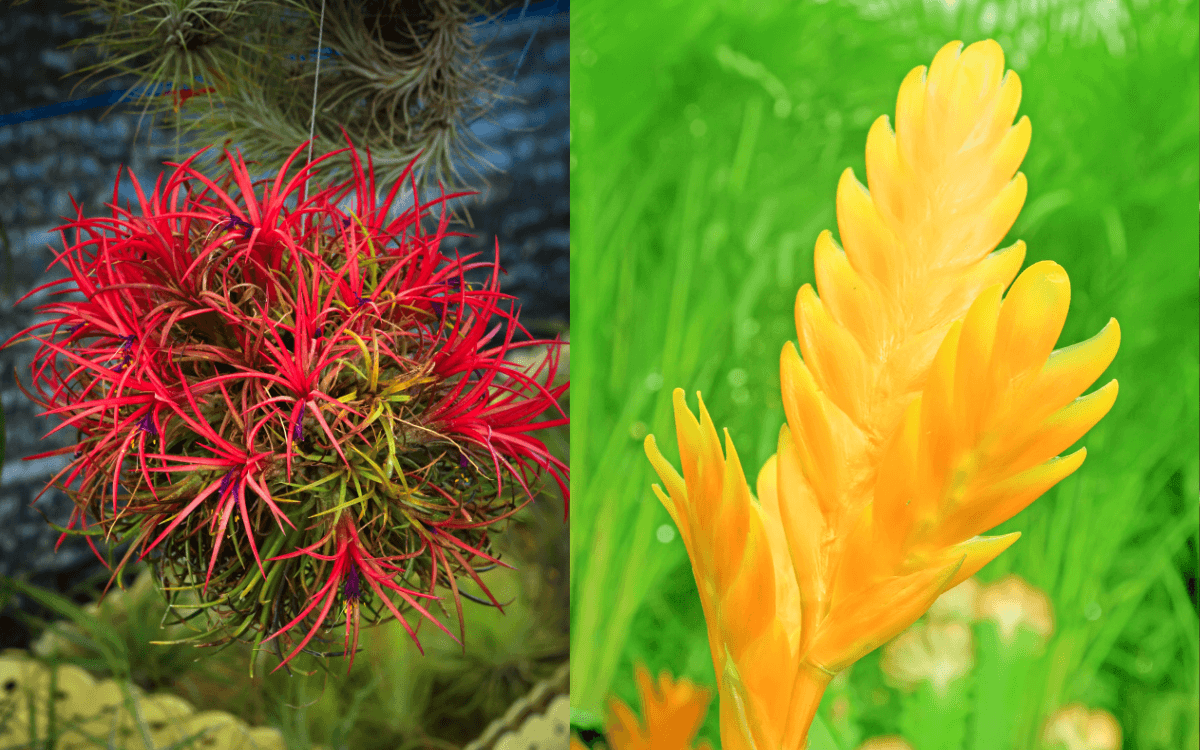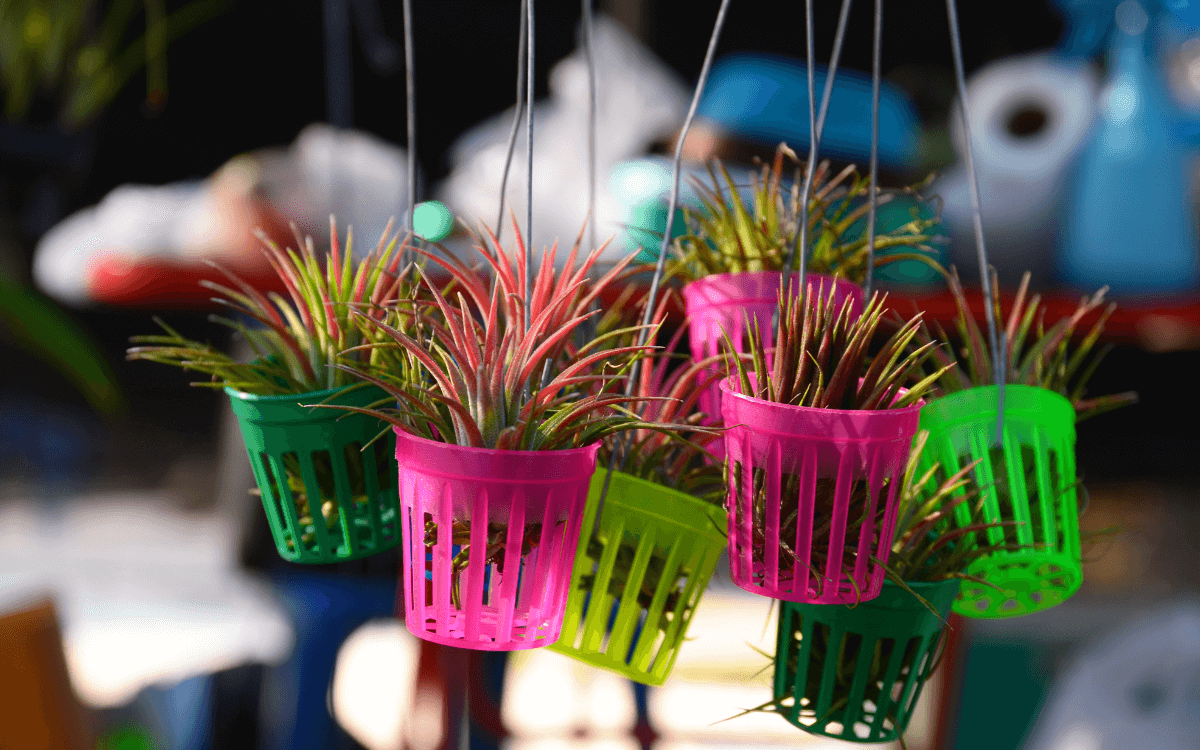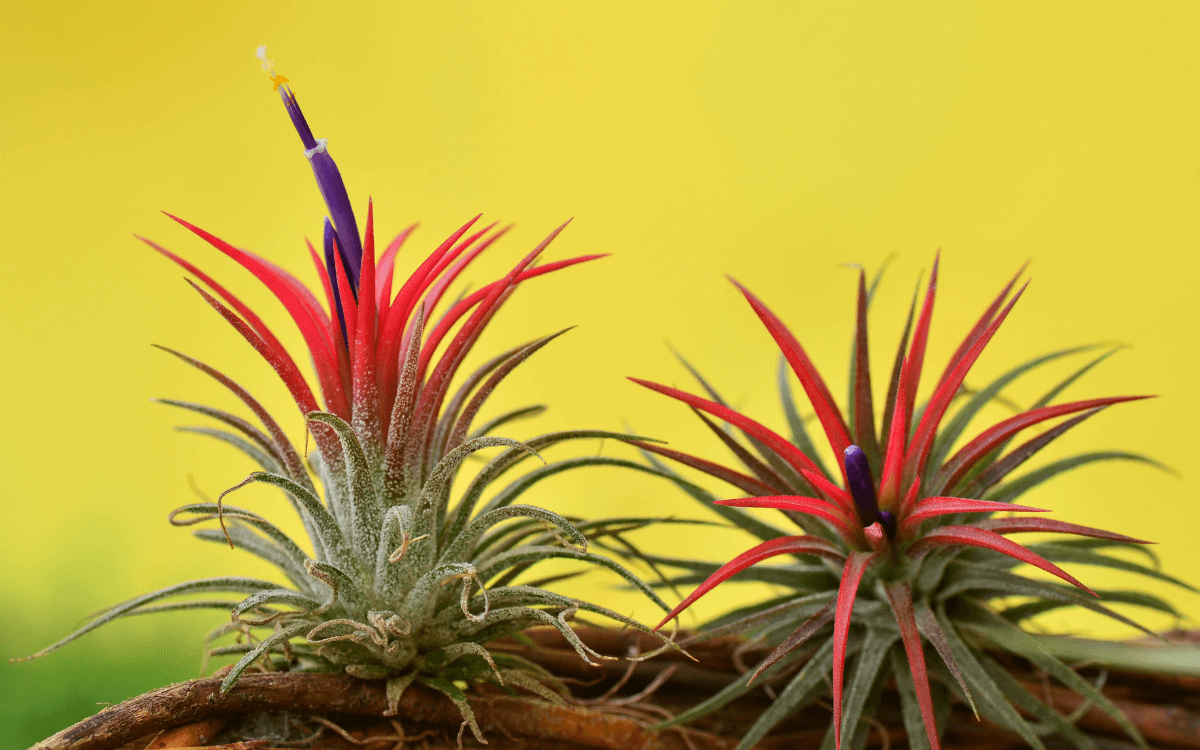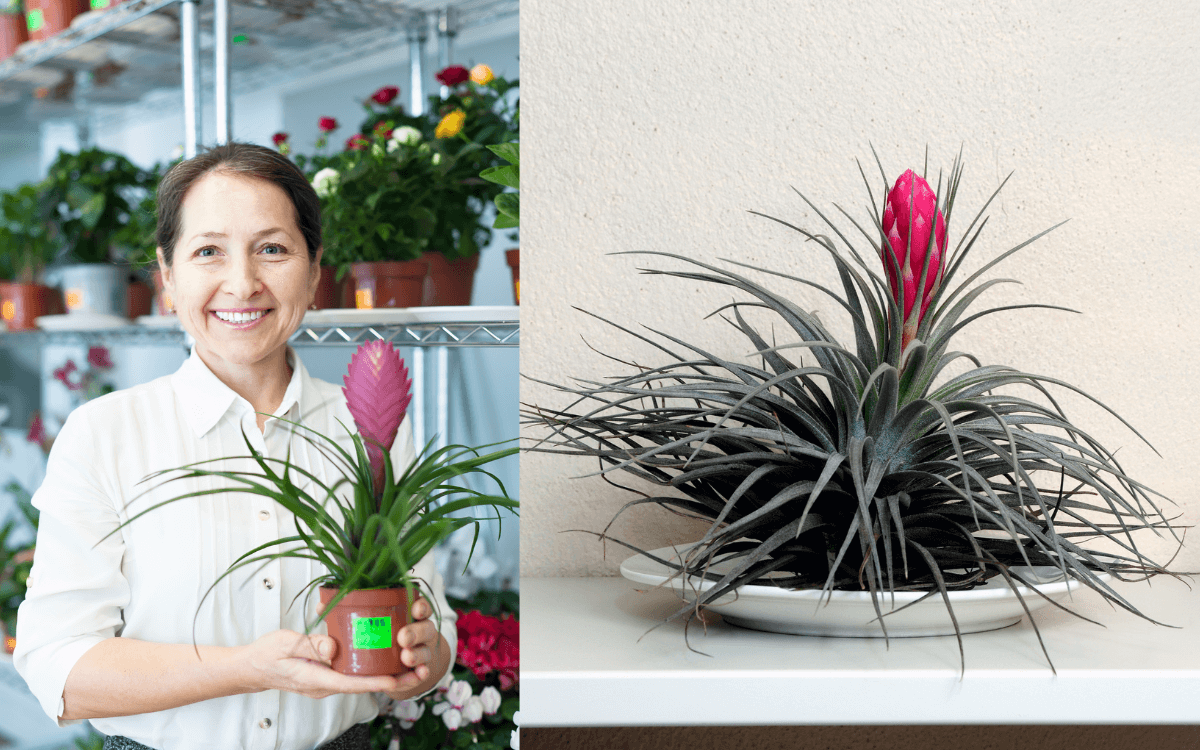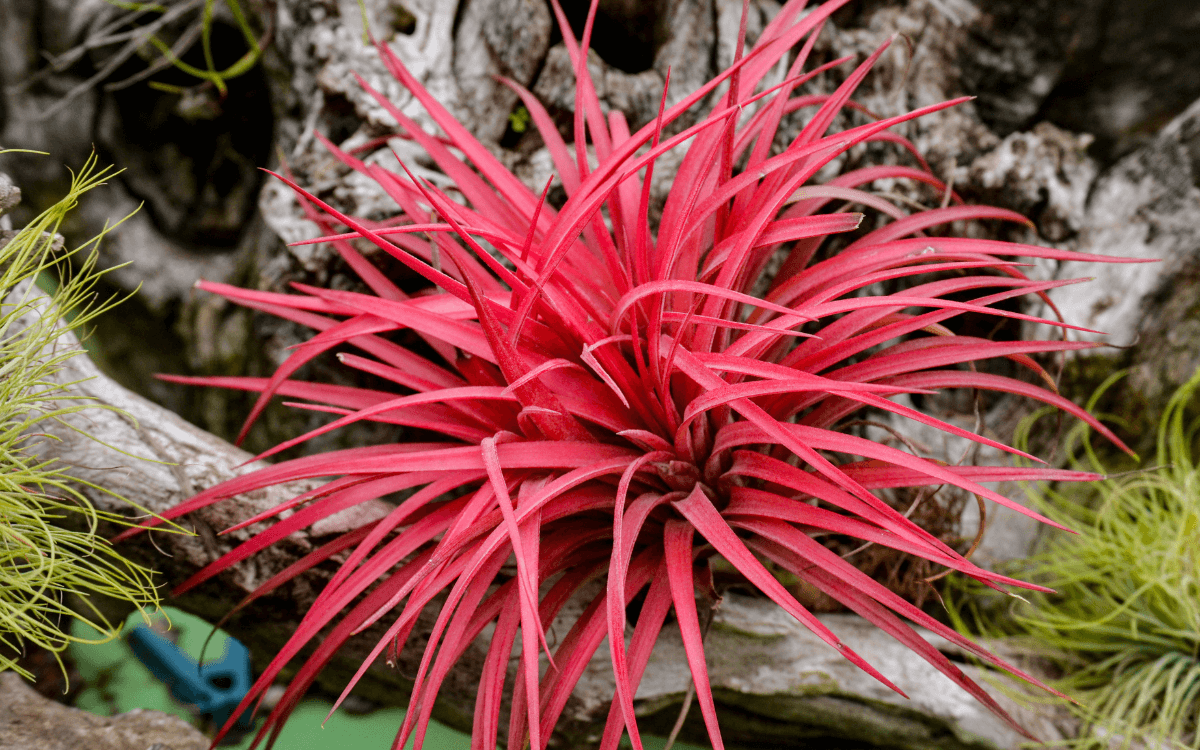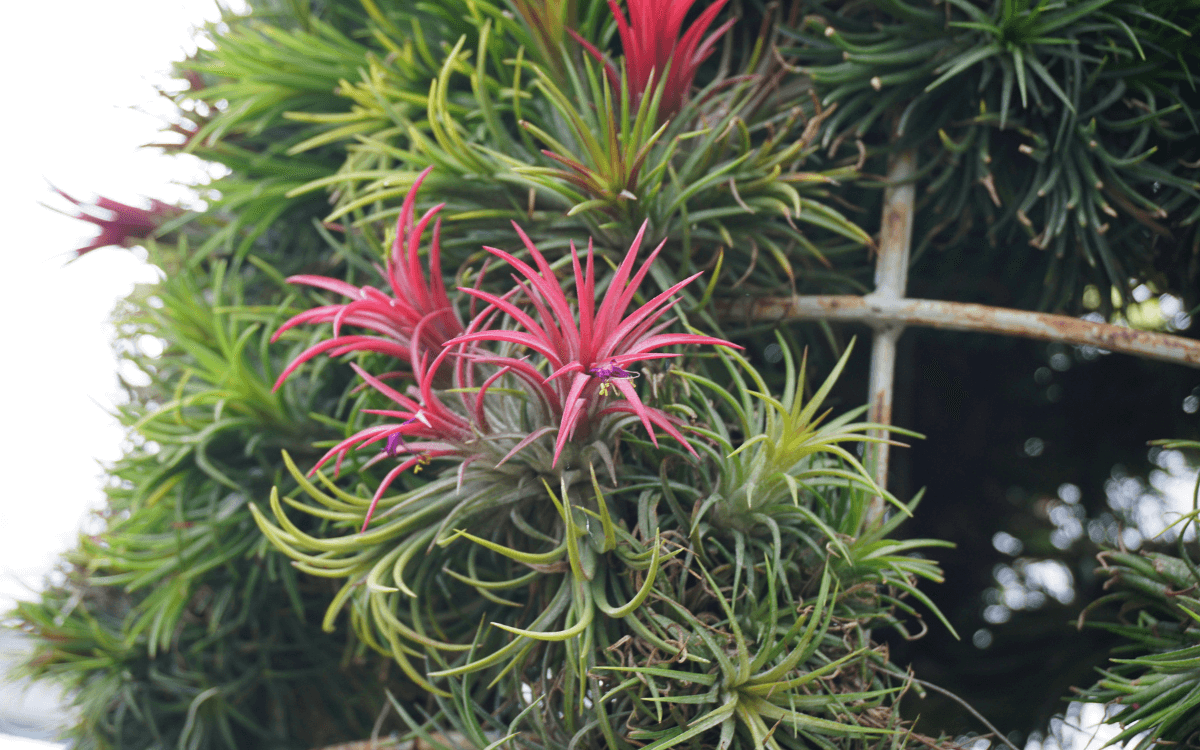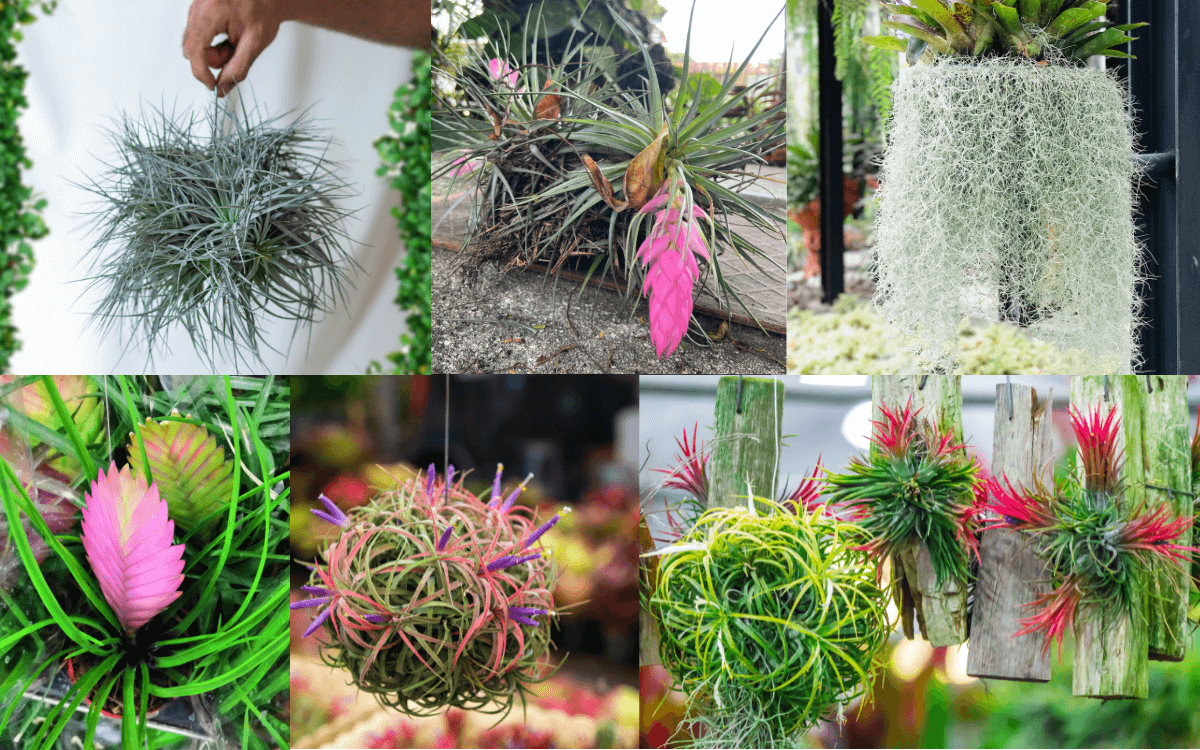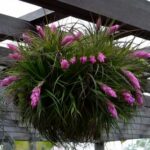Known as “Air Plants”, Tillandsias belong to the Bromeliceae family.
As the nickname already informs, these are plants that should be cultivated hanging and preferably without the use of substrates.
Originating from tropical, desert, and even mountainous regions of the Americas, Tillandsias are attractive plants that have won the space of many homes around the world.
Continue reading, because, in this article, we will explore the distinct characteristics, origin, and cultivation practices of these plants.
Plant Characteristics
Tillandsias are part of one of the largest genera of bromeliads, encompassing more than 400 species that are widely distributed throughout the American continent.
These plants display a remarkable diversity in shape and size, ranging from thin, filamentous leaves to compact and expansive rosettes.
One of their most notable features is the presence of trichomes on the leaves, specialized structures that allow for efficient absorption of water and nutrients from the air.
These adaptations allow Tillandsia air plants to attach to a variety of locations, such as:
- Rocks
- Trunks
- Tree bark
- Pots
Adapting in environments ranging from arid deserts to moist tropical forests.
In addition to their striking appearance, Tillandsias have a life cycle adapted to improve light and nutrient absorption in environments where competition for resources is intense.
Curiosities
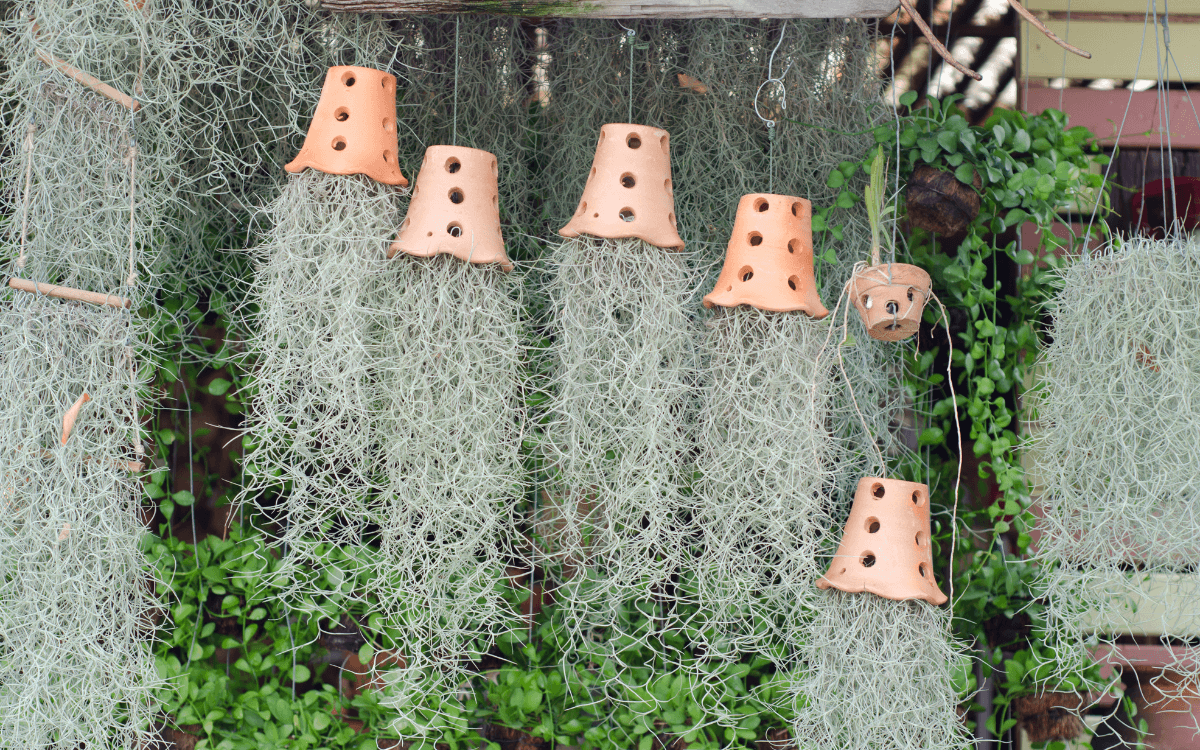
Now that you have learned the main characteristics of this plant, below are listed some curious information about Tillandsias.
- Tribute to a historical figure: named in honor of the Finnish doctor and botanist Dr. Elias Erici Tillandz, the genus Tillandsia reveals the close relationship between botany and history.
- The diversity of species within this genus: with more than 400 types spread across the Americas. This broad geographical dispersion reflects the extraordinary adaptability of Tillandsia air plants to a vast range of environments.
- Its physical forms that fall into three main categories: species with thin leaves, species with thin leaves with scales at the base, and those with larger, less dense leaves.
- Its role in culture, economy, and even pharmacology: its unique aesthetics and low maintenance make them popular in interior design and gardening, while research continues to explore their potential medicinal benefits.
Below we will explore the main care you must take to keep your Tillandsias healthy.
Where to Plant
These “air plants” can be grown both indoors and outdoors.
Indoors
Inside the house, Tillandsias stand out for their decorative versatility.
They can be displayed in transparent glass pots, hung on wire supports, or arranged on stones, wood, shells, and other hard surfaces.
The key to their success indoors is good air circulation and exposure to indirect light. Places near windows, yet protected from direct sunlight, are ideal.
Environments like bathrooms, where humidity is naturally higher, can be particularly conducive to their cultivation, as long as there is enough light.
Outdoors
Outdoors, Tillandsias thrive in well-ventilated and lit locations, but, again, it is crucial to avoid direct sun exposure, which can damage their delicate leaves.
Hanging them on trees or arranging them on trunks and rocks are charming options, mimicking their natural habitat.
During the summer, Tillandsia air plants can enjoy the outdoor environment, but it is important to protect them from low temperatures, bringing them indoors in the colder months.
Ideal Climate
One of the most critical factors for the successful cultivation of Tillandsias is humidity. These plants thrive in environments with high relative humidity, ideally 50% or more.
This requirement reflects their tropical origins, where air humidity is naturally high.
For growers in drier climates, it is essential to employ strategies to increase humidity, whether through regular misting or using humidifiers.
As for temperature, Tillandsias prefer warm conditions, with an ideal range between 18-30°C (64-86°F).
This temperature range supports the healthy metabolism of the plant, promoting growth and flowering.
It is crucial to protect the plants from extreme temperatures; temperatures below 10°C (50°F) can be harmful, as well as prolonged exposure to temperatures above 30°C (86°F), especially without adequate ventilation.
Light is another vital component for the cultivation of Tillandsias. They need a lot of lighting, but must be protected from direct sunlight, which can damage their delicate leaves.
Indoors, artificial light, such as full-spectrum fluorescent lamps, can provide the necessary light intensity without the risk of sunburn.
Tillandsias benefit from good air circulation, which helps prevent moisture buildup on the leaves and promotes efficient gas exchange.
This is especially important indoors, where stagnant air can encourage the development of diseases.
Placing plants in locations where air naturally circulates, away from direct heat sources, like radiators, can help maintain a healthy environment for Tillandsias.
How to Water
Tillandsias should be watered in a way that all parts of the plant are completely wet, usually once to twice a week, depending on the environment in which they are.
In dry climates or indoors with air conditioning, it may be necessary to increase the frequency of watering or supplement with misting to maintain adequate humidity.
Watering in the morning is ideal, as it gives enough time for the plants to dry completely before night, minimizing the risk of rotting.
Below are other tips that will help in your watering:
- Type of Water: It is recommended to use rainwater, filtered, or tap water that has been left to sit to dissipate chlorine.
- Drying After Watering: it is important to ensure that your Tillandsia air plant dries completely within 3 hours after being watered. This is essential to prevent rotting, especially in the center of the plant where water can accumulate more easily.
- Signs of Inadequate Watering: a Tillandsia that is not receiving enough water may present excessively curled or wrinkled leaves, while overwatering can lead to visible rotting and a sick plant.
Soil
Tillandsias do not require soil for their growth and development.
As epiphytes, they have adapted to live attached to other surfaces, absorbing nutrients and moisture directly from the air through their leaves.
Therefore, planting in pots is not ideal.
However, if you want to plant your Tillandsia in a pot, below are some substrates that can be used for this plant:
- Sphagnum moss
- Coconut fiber
- Pine barks
- Stones
- Shells
- Perlite,
- Vermiculite
Some substrates are used especially to fix the plant on trees, an alternative to them are wire supports, which offer the necessary structure for the plants to cling and at the same time allow excellent drainage and air flow.
Fertilization
Although not strictly necessary for the survival of these plants, fertilization can help promote more vigorous growth and stimulate flowering.
Tillandsias absorb nutrients mainly through their leaves, instead of roots in soil, which makes foliar fertilization the recommended approach to supplement their nutrition.
The use of a specific liquid fertilizer for bromeliads is advised, diluted in water according to the manufacturer’s instructions, to avoid excessive concentration of mineral salts.
This solution should be applied directly to the leaves and at the base of the plants, allowing efficient absorption of nutrients.
Monthly application during the warmer and actively growing months, spring and summer, is sufficient to support the overall health and development of Tillandsia air plants.
It is crucial to avoid fertilizers that contain copper (Cu) or zinc (Zn) in their composition, as these elements can be toxic to Tillandsias. Toxicity can lead to the deterioration of the plant’s health, compromising its growth and ability to flower.
Correct dilution of the fertilizer is essential to avoid over-fertilization, which can result in the accumulation of harmful mineral salts to the plant.
Plants under stress, young or recently transplanted should be spared from fertilization until they establish and show signs of healthy growth. This practice ensures that fertilization benefits the plant, rather than imposing additional stress.
Pruning
Tillandsias may need occasional pruning to remove dead or damaged leaves, thus maintaining the health and aesthetics of the plant.
Pruning should be done carefully, using clean and sharp tools to avoid damaging the healthy tissue.
Dead leaves should be gently removed, without pulling firmly attached leaves, to not hurt the plant.
Pruning not only helps in appearance but also prevents the proliferation of fungi and bacteria on dead material.
Multiplication
Using some techniques, it is possible to multiply your Tillandsias, although the process may require patience and care.
Offshoots
One of the most common ways to multiply Tillandsias is through the careful removal of offshoots that emerge at the base of the mother plant.
These offshoots can be separated from the mother plant when they reach about a third of their size, usually after a few months of growth.
The removal process should be done carefully to not damage the mother plant or the offshoot, using a clean and sharp scissors if necessary.
Seed Propagation
Although it is a more time-consuming and less common process, propagation of Tillandsias from seeds is possible.
For this, it is necessary to obtain high-quality seeds and plant them in a mix of sphagnum moss and perlite, creating a moist and well-lit environment to favor germination.
This method requires patience, as it can take several months or even years for the seedlings to grow into adult plants.
Vegetative Reproduction
Another technique involves vegetative reproduction, cutting or dividing the Tillandsia air plant into smaller sections.
This approach can be applied to certain species that allow such division without harming the plant’s health.
Careful replanting and maintaining the right conditions of humidity and light are essential for the success of this technique.
Pests and Diseases
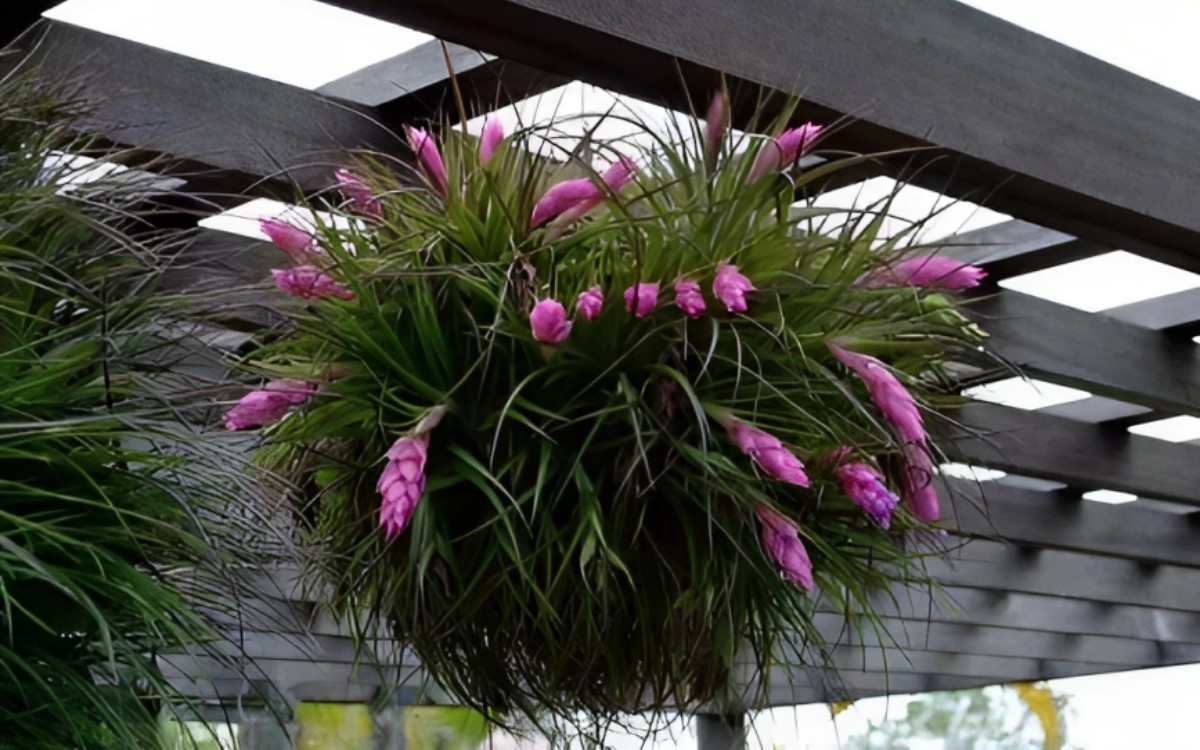
Tillandsias, although they are resilient plants, are not immune to pests and diseases. Below we will address the main problems that may appear in your plant.
Common Pests
Among the pests most frequently found in Tillandsias are:
- Scale insects
- Aphids
- Mites
- Fruit flies.
These parasites can cause significant damage to plants, sucking their nutrients and leaving them weakened.
The presence of scale insects is noted by the cotton-like appearance they leave on the leaves, while mites and aphids can be identified by small spots or discolorations on the leaves.
Pest Control:
For effective control of these pests, regular inspection of plants and the application of preventive measures are recommended.
This may include washing the leaves with a solution of water and neutral soap or the use of organic insecticides, like neem oil, which is less harmful to plants and the environment.
Manual removal of pests may also be necessary in light infestations.
Common Diseases
Tillandsia air plants can also suffer from diseases caused by fungi, such as root and stem rot, as well as sunburns or damage caused by extreme cold.
These conditions are the result of inadequate care, such as excess moisture, lack of air circulation, or direct exposure to sun or very low temperatures.
Disease Prevention and Treatment
Prevention is the key to keeping Tillandsias free of diseases.
This includes ensuring adequate air circulation, correct watering (avoiding waterlogging), and protection against extreme weather conditions.
If the plant is affected by fungi or other diseases, the application of a specific fungicide may be necessary, in addition to the removal of affected parts of the plant to prevent the spread of disease.
Main Species
Some of the most famous species in the Tillandsia genus are:
- Tillandsia ionantha
- Tillandsia cyanea
- Tillandsia usneoides
- Tillandsia bulbosa
- Tillandsia xerographica
- Tillandsia streptophylla
- Tillandsia leiboldiana
- Tillandsia juncea
- Tillandsia lindenii
- Tillandsia recurvata
- Tillandsia stricta
- Tillandsia pohliana
- Tillandsia aeranthos
- Tillandsia streptocarpa
Conclusion
If you want to learn more about Tillandsias, here on the blog we have already published an article about the Tillandsia stricta species, which is popularly known as stricta air plant (click here to access the article).
Now, if you want to learn about other plants you can use to decorate your home or garden, below I have separated some recommendations for you.
- Ribbon Fern or Cretan Brake Fern: How to Plant and Care
- Vanilla Orchid: How To Plant, Care and Grow (With Photos)
- Orange Jasmine: Curiosities, How to Care and Photos
- Myrtle (Myrtus communis): Characteristics and Care
- African Iris: How to Care and Propagate
- Sandpaper Vine (Petrea volubilis): Care and Propagation
- China Rose (Rosa chinensis): 8-Step Care Guide
Did you like this text? Then leave a comment below and share it on your social networks, as this helps us a lot.

